The ransom broke from the first Raphaelites against academic traditions. Millais unified the scene and paid close attention to the details of early Renaissance paintings. Instead of using a focused light or a synthetic pyramid, he focused on the central character of the knight.
He also focused on the configuration of the monument on rather than the Royal College of Art (based on lessons learned in Raphael's school), Millais would put everyone on one level. The environment of the sixteenth century and the majestic theme of this painting evoke the Medieval Ages and the primitive charm of Raphael. Inspired by Keats, Tennyson, and Shakespeare, the early predecessors of the Raphaelites considered the medieval environment as a canvas and could thus criticize contemporary society. The ransom does not have a moral slogan but, it can still be seen as a complement to Millais’s long-term line of work on the family, the status of women, and the patriotic responsibilities during the Victorian era Mid-nineteenth century. The guy in front of Rafael, Augustus Leopoldo, painted his past and present collections in 1858. The ransom can be considered as a medieval means against the moral warnings of the Victorian era: a morally simplified story of rescue which allows the viewer to sympathize with their families.
The ransom leaves the first faction Raphaelite, highlighting the importance given to aesthetic principles and transcendence in an ambiguous environment. Millais created historical paintings of the 1950s based on the famous confrontation and battle. On the other hand, the ransom is a work of his invention. Beauticians sometimes deliberately choose subjects without historical or literary background or take great artistic freedom on this subject. This painting is not a story of conspiracy and history but focuses on curtains and detailed patterns. The fox on the left side of the picture saw that they were hungry. Millais may be trying to show in the subtle plot of the action that the knight’s negligence led to the kidnapping of the girl. But one cannot conclude this exclusively as the ransom can be interpreted from different angles.
Since the Pre-Raphaelite period, Millais has become a somewhat famous person. Millais follows Rosetti and Frederick Leighton and other aesthetic works; the latter has eagerly achieved. He focused his attention on patterns and aesthetics complex to integrate into his work. This shows his recognition of opportunities to benefit from. If otherwise, it seems impossible to attempt to create a medieval scene from his imagination without an apparent plot to represent his other paintings.




